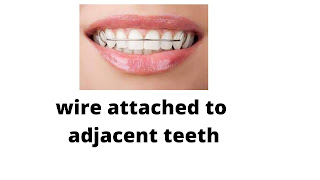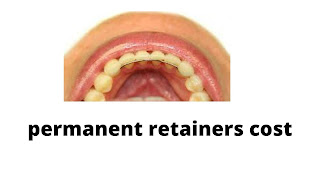permanent retainer how much do permanent retainers cost
 |
The permanent retainer (fixed orthodontic retainers in Barcelona ) is used in Propdental Clinics,
in those situations in which intra-articular changes are expected and prolonged retention means intended.
permanent retainer
Contents
- What is a fixed retainer and what is it for?
- Maintaining the position of the lower incisors
- Recurrence of crowding
- Maintenance of the diastema
- Maintenance of the pontic or implant space
- permanent retainers cost
- Maintenance of closed extraction spaces in adults
What is a permanent retainer and what is it for?
 |
There are four fundamental indications of the permanent retainer:
Ensure that the position of the lower incisors is not altered and does not move after orthodontics.
Let's see, Maintenance of the diastema.
If you lose a tooth and need to keep space for a dental implant.
Maintenance of closed extraction spaces in adults
Maintaining the position of the lower incisors
As we have already mentioned, the main cause of crowding of the lower incisors during the final years of youth and is the late growth of the jaw according to the normal growth pattern.
however, Especially if the lower incisors were previously irregularly placed.
Even a small differential mandibular growth between the ages of 16 and 20 can cause crowding to recur.
fixed orthodontic retainer
Recurrence of crowding
The recurrence of crowding is almost always accompanied by the lingual inclination of the central
and lateral incisors in response to the growth pattern.
An orthodontic retainer is excellent for keeping these teeth aligned - it is a fixed lingual bar,
anchored only to the canines (or to the canines and first premolars) and supported on the flat lingual surface of the lower incisors above the cingulum.
In this way, the incisors are prevented from moving lingually
and the correctness of rotation in the incisor segment can be reasonably maintained.
Canine to Canine Fixed Retainers
The fixed retainers from canine to canine should be a wire thick enough to withstand the distortion along the length of the margin as the wide separation between these teeth.
28- or 30-mil steel with a looping bend at the end of the wire used to be used to improve retention. With this design, a cemented retainer can remain in place for many years.
Although there is concern about its long-term effect on periodontal health.
on the other hand, Long-term reviews of patients who have worn cemented retainers for more than 20 years have shown no periodontal problems.
so It is also possible to attach a fixed lingual retainer to one or more incisors.
The main indication for this variant is the very riirritation accentuated rotation of a tooth. However, whatever the type of retainer used, the teeth should not be rigidly immobilized during retention.
For this reason, if we reduce the span of the retaining wire by adhering it to one or more intermediate teeth, a more flexible wire will have to be used.
A good option for a fixed retainer attached to adjacent teeth is a 17.5 mil diameter braided steel wire archwire.
Maintenance of the diastema
The second indication for a fixed retainer is a situation in which some teeth have to be bonded permanently or unimportant to maintain the closure of the space between them.
This usually happens when a diastema has closed between the upper central incisors.
Even if a frenectomy has been performed, a small gap tends to open between the maxillary central incisors.
In these cases, the best retainer is an attached segment of flexible wire.
Wire so that it is close to the cingulum to move it away from occlusal contact :
The wire must be molded close to the cingulum to move it away from occlusal contact.
The orthodontic retainer holds the teeth together, allowing them some independent mobility during their function (hence the of the wire being flexible).
An alternative is a solid wire configured to avoid contact between the teeth (facilitating the use of dental floss).
And that can also incorporate stops to prevent the bite from deepening.
A removable retainer is not a good choice for prolonged retention of a central diastema.
In problematic cases, the diastema is closed when the retainer is removed but reopens quickly.
The dental movement that accompanies this do the same closure can be detrimental in the long term.
Maintenance of the pontic or implant space
A fixed retainer is also the best option to maintain the space in which a bridge or implant will be placed later.
Using a fixed retainer for a few months) reduces dental mobility and it is usually easier to place the fixed bridge that will serve among other things) as a permanent orthodontic retainer.
If additional periodontal treatment is required after tooth repositioning.
It may take months or even years before the bridge is ever placed, so a fixed retainer will undoubtedly be needed.
Dental implants should be placed as soon as possible after orthodontics is completed so that they can be integrated during the initial retention phases.
Intracoronary wire attached to adjacent teeth
The best orthodontic retainer to maintain a posterior pontic space is a thick intracoronal wire attached to the adjacent teeth (in shallow preparations if they are future teeth for a bridge).
Obviously, the greater the gap, the thicker the wire should be. By lowering the wire away from the occlusion, we reduce the chances of it being displaced by occlusal forces. A replacement tooth is required for anterior spaces, which can be anchored to a removable retainer.
With this system, almost constant use of the appliance is guaranteed and satisfactory results are obtained for short periods.
After a few months, especially if implant or bridge placement is to be delayed for a long time while vertical growth is completed during adolescence, it is best to place a fixed retainer in the form of an adhesive bridge.
Permanent Retainer Cost After Braces (wearing a retainer
Retainers are vital a part of obtaining your teeth straightened. Once you have got had your teeth straightened with the braces possibility of your selection, you'll get to have retainers.
This is as a result of it's terribly natural for your teeth to do and relapse back to their original crooked position. As a part of all of our dentistry packages, we tend to do embody each mounted and removable retainer. The mounted retainers are warranted on the backs of your teeth straightaway when having your brace is launched. we tend to then take impressions of your teeth which is able to be sent to our workplace to form the removable retainers.
The mounted retainers are worn indefinitely thus you mostly have retention in situ. The removable retainers are to be used throughout the night and can double au courant the retention.
We continually advise patients before they need braces that retainers can get to be fitted/worn following treatment to confirm the teeth keep in their new positions.
Maintenance of closed extraction spaces in adults
A fixed retainer is more reliable and better tolerated than a removable one with constant wear and the gaps reopen unless the retainer is worn without interruption.
In adult patients, it may be preferable to adhere a fixed retainer to the facial surface of the posterior teeth, and once the gaps have been closed.
The main drawback of fixed retainers is that they make interproximal hygiene difficult.
The wire of a maxillary fixed retainer can be contoured to allow access to the interproximal area.
It is possible to floss between teeth that have a fixed retainer using a floss threading device.
With proper flossing, there is no reason not to leave fixed retainers in place indefinitely, if necessary.






.png)
1 Comments
pak job alerts 2021
ReplyDeletepak job alerts 2021